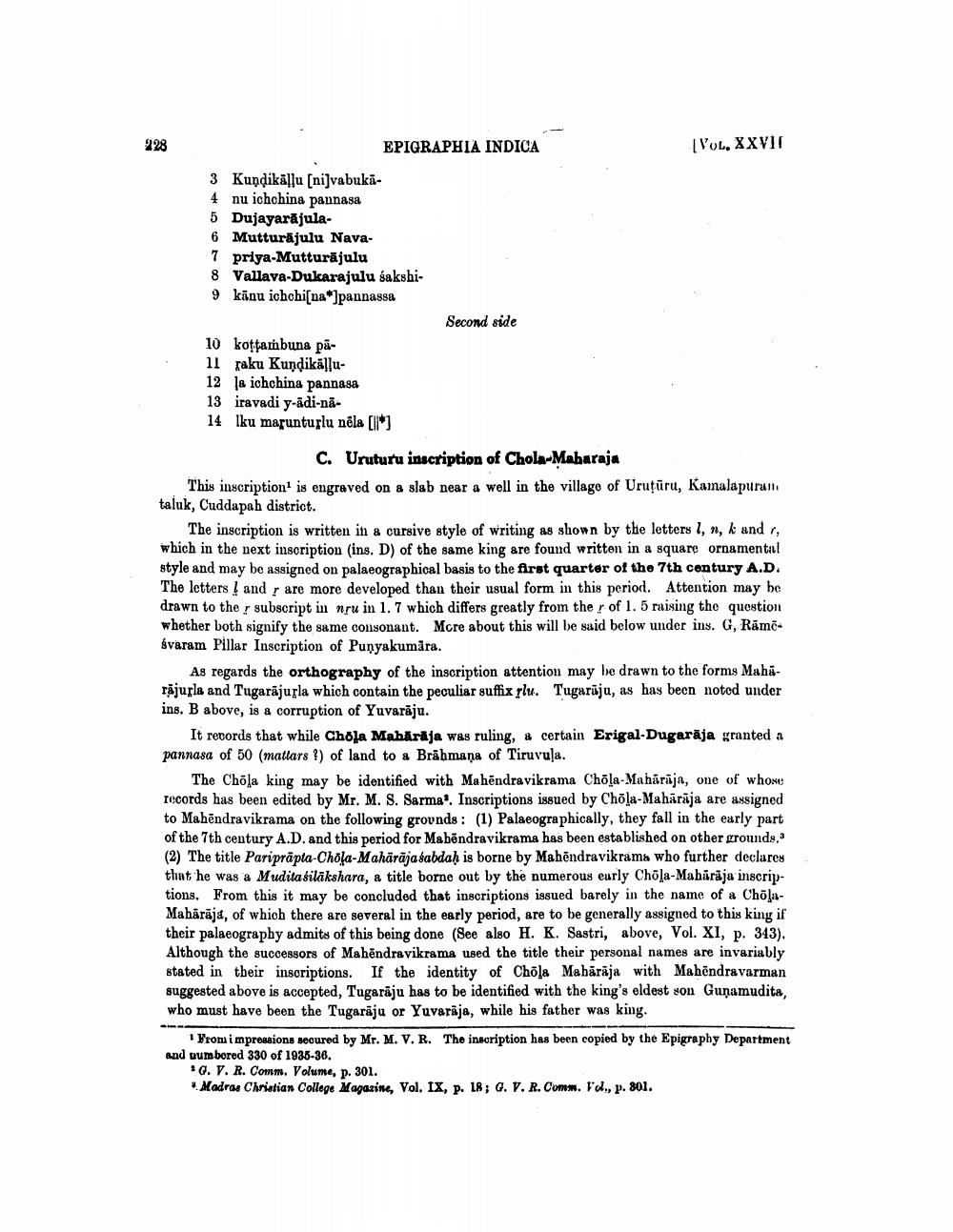________________
228
EPIGRAPHIA INDICA
(VOL. XXVII
3 Kundikāļļu (ni]vabuka4 nu ichchina pannasa 5 Dujayarājula6 Mutturājulu Nava7 priya-Mutturājulu 8 Vallava-Dukarajulu sakshi9 kūnu ichchi[na*]pannassa
Second side 10 kottarbuna pā11 raku Kundikāļļu12 la ichchina pannasa 13 iravadi y-ādi-na14 lku maruntuflu nola [I1*]
C. Uruturu inscription of Chola-Mabaraja This inscription is engraved on a slab near a well in the village of Urutūru, Kamalapuram taluk, Cuddapah district.
The inscription is written in a cursive style of writing as shown by the letters I, n, k and r, which in the next inscription (ins. D) of the same king are found written in a square ornamental style and may be assigned on palaeographical basis to the first quarter of the 7th century A.D. The letters and r are more developed than their usual form in this period. Attention may be drawn to the r subscript in nou in 1.7 which differs greatly from the r of 1.5 raising the question whether both signify the same consonant. More about this will be said below under ins. G, Rămēsvaram Pillar Inscription of Punyakumära.
As regards the orthography of the inscription attention may be drawn to the forms Maharājupla and Tugarājufla which contain the peculiar suffix rlu. Tugarūju, as has been noted under ins. B above, is a corruption of Yuvarāju.
It records that while Chola Maharaja was ruling, a certain Erigal-Dugarāja granted a pannasa of 50 (matlars ?) of land to a Brāhmaṇa of Tiruvula.
The Chõla king may be identified with Mahendravikrama Chola-Mahārāja, one of whose records has been edited by Mr. M. S. Sarma. Inscriptions issued by Chõla-Mahārāja are assigned to Mahēndravikrama on the following grounds : (1) Palaeographically, they fall in the early part of the 7th century A.D. and this period for Mabēndravikrama has been established on other grounds. (2) The title Pariprāpta-Chola-Mahäräja sabdah is borne by Mahondravikrama who further declares that he was a Mudita silākshara, a title borne out by the numerous eurly Chõla-Mahārāja inscriptions. From this it may be concluded that inscriptions issued barely in the name of a CholaMahārāja, of which there are several in the early period, are to be generally assigned to this king if their palaeography admits of this being done (See also H. K. Sastri, above, Vol. XI, p. 343). Although the successors of Mahendravikrama used the title their personal names are invariably stated in their inscriptions. If the identity of Chõla Mabăraja with Mahendravarman suggested above is accepted, Tugarāju has to be identified with the king's eldest son Guņamudita, who must have been the Tugarāju or Yuvarāja, while his father was king.
From impressions secured by Mr. M. V.R. The inscription has been copied by the Epigraphy Department and bumbored 330 of 1935-36.
G. V. R. Comm. Volume, p. 301. Madras Christian College Magazine, Vol. IX, p. 18; G. V. R. Comm. Val., p. 801.




